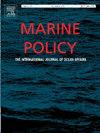Bluefin tuna TAC Case: Lessons for Japanese fishery resources management
IF 3.7
2区 社会学
Q2 ENVIRONMENTAL STUDIES
引用次数: 0
Abstract
In Japan, the management of fishery resources has traditionally been implemented through non-binding administrative guidance and fishermen’s voluntary efforts rather than legally binding catch limits. This “soft” approach has often resulted in ineffective resources management in controlling the harvest levels in relation to the reproductive capacity of stocks. In 2014, the Western and Central Pacific Fisheries Commission (WCPFC) adopted stringent measures to rebuild the depleted stock of Pacific bluefin tuna. Consequently, Japan was mandated to restrict the national harvest levels within the limits assigned by the WCPFC from the fishing year 2015. The Japanese government assigned a quota to each control division (e.g., prefectures and fishing sectors), but they lacked a legal foundation. Subsequently, the non-legally binding quotas were repeatedly exceeded. In 2017, the Japanese government finally designated Pacific bluefin tuna as a species whose harvest is regulated by a total allowable catch (TAC). In Hokkaido Prefecture, where significant overage occurred prior to the introduction of legally binding TAC regulations, the subsequent management periods saw a prohibition on harvesting small-sized bluefin tuna, which led some small-scale fishermen in the Rumoi Sea Area to file a lawsuit. This particular case highlights the inadequacies inherent in Japan’s traditional approach to the management of fishery resources. The 2018 amendment to the 1949 Fisheries Act aimed at strengthening resources management by employing TACs for major fish stocks. However, concerns have been raised that these novel TAC-based regulations could lead to serious conflict and confusion similar to those observed in the bluefin tuna TAC case.
蓝鳍金枪鱼TAC案例:日本渔业资源管理的教训
在日本,渔业资源的管理传统上是通过不具约束力的行政指导和渔民的自愿努力来实施的,而不是通过具有法律约束力的捕捞限制。这种“软”办法往往导致资源管理在控制与种群繁殖能力有关的收获水平方面无效。2014年,西太平洋和中太平洋渔业委员会(WCPFC)采取了严格的措施来重建枯竭的太平洋蓝鳍金枪鱼种群。因此,日本被授权从2015捕鱼年开始将国家捕捞量限制在世界鱼类保护委员会规定的限度之内。日本政府给每个管制部门(如县和渔业部门)分配了配额,但缺乏法律依据。随后,不具法律约束力的配额一再被超过。2017年,日本政府最终将太平洋蓝鳍金枪鱼指定为一个受总允许捕获量(TAC)管制的物种。在北海道县,在引入具有法律约束力的TAC法规之前就发生了严重的过度捕捞,随后的管理时期禁止捕捞小型蓝鳍金枪鱼,这导致了鲁莫伊海域的一些小规模渔民提起诉讼。这一特殊情况突出了日本管理渔业资源的传统办法所固有的不足之处。2018年对1949年《渔业法》的修正案旨在通过对主要鱼类种群采用tac来加强资源管理。然而,有人担心,这些基于TAC的新规定可能导致严重的冲突和混乱,类似于蓝鳍金枪鱼TAC案件中所观察到的情况。
本文章由计算机程序翻译,如有差异,请以英文原文为准。
求助全文
约1分钟内获得全文
求助全文
来源期刊

Marine Policy
Multiple-
CiteScore
7.60
自引率
13.20%
发文量
428
期刊介绍:
Marine Policy is the leading journal of ocean policy studies. It offers researchers, analysts and policy makers a unique combination of analyses in the principal social science disciplines relevant to the formulation of marine policy. Major articles are contributed by specialists in marine affairs, including marine economists and marine resource managers, political scientists, marine scientists, international lawyers, geographers and anthropologists. Drawing on their expertise and research, the journal covers: international, regional and national marine policies; institutional arrangements for the management and regulation of marine activities, including fisheries and shipping; conflict resolution; marine pollution and environment; conservation and use of marine resources. Regular features of Marine Policy include research reports, conference reports and reports on current developments to keep readers up-to-date with the latest developments and research in ocean affairs.
 求助内容:
求助内容: 应助结果提醒方式:
应助结果提醒方式:


